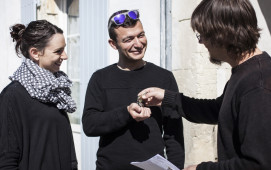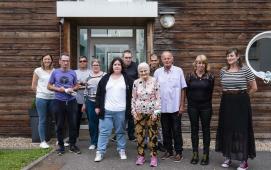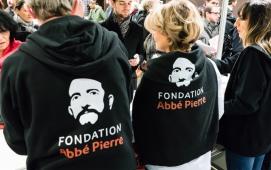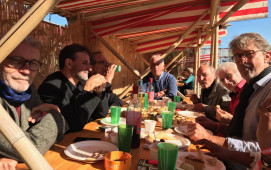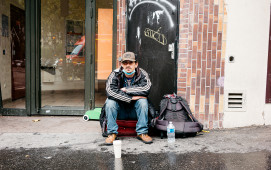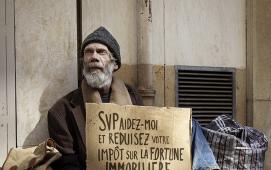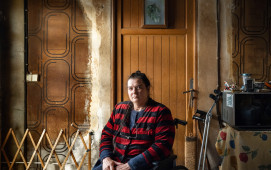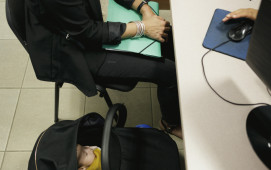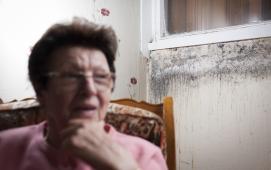The insurrection of kindness
As soon as the Abbé finishes delivering his speech, phone calls flood Radio-Luxembourg’s switchboard. The listeners want to know where to send money, clothes, blankets, furniture, heating equipment. Caught unawares, the Abbé Pierre throws in an address: Rochester hotel, 92 La Boétie Street in the very chic 8th arrondissement of Paris. He remembers that the owner, Mrs Lamier, offered to put a few rooms at his disposal. The donations are so numerous that soon the whole hotel is converted into a warehouse.
Room 412 becomes the Abbé’s headquarters, who demands phone lines (“tell them to unplug the phone lines of dog’s beauty salons and to give them to us!”). In that same day, February 1, he asks the Paris mayor to leave fifty subway stations open for the night. Following never-ending discussions, four abandoned stations are put at the disposal of the homeless (Rennes, Liège, Champ-de-Mars and Saint-Martin, which alone will shelter up to 750 persons!). During this “Night of Charity”, four emergency centres loom in the Paris region. “No one slept outside in Paris last night”, France-Soir runs as headline the next morning.
During the following days, actions multiply: The students from Polytechnique, doubling as switchboard operators, launch the “Maid’s room Operation”; some police stations are converted into reception centres. Donations arrive from all sides, including from abroad. Letters simply addressed to “Abbé Pierre, France”, reach their destination. Soon, the Rochester hotel isn’t big enough to receive the numerous donations. The Abbé then asks to have access to the abandoned Orsay train station, which was being used as a garage. After four days of talks, the station can finally receive tonnes of clothes and staple goods, collected by emergency centres. On the façade, a huge banner hangs: “Hope station, Paris is helping you”.
The Printemps department stores launch the “hundred francs for Abbé Pierre” operation. In just a few days, the walls and roof of a life-size cardboard model house are covered with 100 francs bills. Artists and public figures join the solidarity momentum. Michel Simon himself delivers an envelope containing one million francs! A Parisian art gallery organises an auction of paintings by famous painters (Braque, Chagall, Matisse…) and the proceeds are given to the Abbé. Charles Trenet buys for 1 750 000 francs a portrait of the Abbé by Rouault. In just one week, collected funds reach 500 million old francs (close to 8 million Euros). On February 4, the Assembly finally votes an exceptional loan of 10 billion francs (more than 150 million Euros) for the construction of 12 000 emergency housing units. The next day, the Abbé signs a first contract to launch the construction site of forty eight houses in Plessis-Trévise.
“The following days are etched in my memory. People were going in and out all the time, hundreds upon hundreds of bills deposited in the baskets… in the evening, three or four of us would carry them upstairs and empty them in the bathtubs of empty rooms. We filled up five… I slept on site, no security system, no fear…”
Daniel Atlan is 20 years old then. He is a porter at the Rochester hotel, in Paris. He still remembers every detail of these historic first hours.
150 million old francs are collected in five days. Emergency centres open everywhere in Paris. 500 beds are set up in the Mutualité, 4 subway stations are opened as well as precarious hosting centres in the Paris region. On February 19, with the help of the Secours Catholique, an 18-heated tent village is put up at Porte d’Orléans.
The city of Paris makes the abandoned Orsay train station available to store goods: the Companions are flooded by blankets, catalytic stoves, clothes, furniture. On February 21, the gifts reach ten thousands tonnes of in-kind donations or re-sellable goods. By mid March, gathered funds exceed one billion, including in-kind donations, the equivalent of 18 millions Euros.
“I had the impression that all of France heard the Call”
To replace the Rochester hotel as headquarters, the Abbé Pierre buys a building in the heart of popular Paris, the Halles, at 32 Bourdonnais Street, using part of the collected funds.
On February 4, the Parliament votes a 10 billion francs programme for 12 000 emergency housings in the Paris region and the rest of the country.
On February 19, the statutes of HLM Emmaüs ltd are approved by ministerial decree. The works on the first emergency estate had begun in Plessis-Trévise ten days earlier. In 3 years, 1500 housing units will be built.
The Parisian activities of emergency assistance to the homeless are brought together in a1901 law association, the Asalp (Aide aux sans-logis de l’agglomération parisienne or Assistance to the homeless of the Parisian urban area). In January 1955, its national homologue is created, the Union nationale d’Aide aux sans-logis (the national union of assistance to the homeless) which will become, in December 1956, the CGL (Confédération générale du Logement or the General Confederation for Housing).
For communication purposes, a magazine, Faim et soif des hommes (hunger and thirst of men) is created in May 54. And last but not least, the international aspect is tackled with the creation of the IRAMM (Institut de Recherche et d’Action sur la Misère du Monde or the Institute of Research and Action on World Misery) in September 54.
In a few short months, the Insurrection of Kindness changed France and the Abbé Pierre became indisputably an icon.

